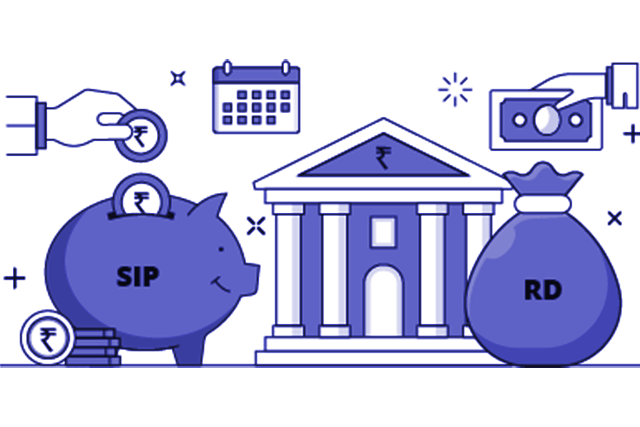SIP vs RD: Which Is a Better?
- By MultiSphere

Setting aside a part of your monthly income can be an interesting way to invest money when you know the scheme will safeguard your investment and build wealth to achieve your financial goals. So, if you are looking for a similar investment option, Systematic Investment Plan (SIP) and Recurring Deposit (RD) are the two most popular options that let you invest a fixed amount every month for long-term wealth creation.
An SIP is a provision to make an investment in mutual funds by setting aside a small amount of money monthly or quarterly rather than investing in a lump sum. On the other hand, an RD is an investment tool wherein you can deposit a fixed amount each month for a fixed interest rate and predefined duration. This article elucidates everything about these two investment options so that you can make an informed investment decision.
What is an SIP?
A Systematic Investment Plan (SIP) is an investment tool that lets you invest a small sum of money in mutual funds on a daily, weekly, monthly, and quarterly basis. It is a systematic approach to managing your investments. Depending upon the mutual fund scheme you choose, your invested money will be allocated in debt and/or equity. You can start an SIP with a minimum of Rs 500 a month. With a standing instruction, the SIP amount will get deducted from your registered bank account on a predefined date. You do not have to worry about market volatility and timing the market as you make small investments periodically, typically for the long term. With increased awareness about mutual funds, this disciplined manner of investment has been gaining popularity in India.
What is a Recurring Deposit?
A Recurring Deposit (RD) is a type of term deposit offered by banks. It lets you make regular deposits and earn interest on the investment. Due to the regular deposit factor and fixed interest rate, RD is one of the preferred saving-cum-investment instruments in India. Most banks in India offer RDs for a term that ranges between 6 months to 10 years. You can choose the term in accordance with your financial goal. The RD amount gets automatically deducted from your Savings Bank Account and is transferred to your RD account. The interest rate remains the same throughout the term and does not get affected by market volatility. On maturity, you receive the lump sum amount that includes your investment plus the interest earned. Most major banks in India offer to invest in RDs with as little as Rs 1,000. Since the rate of interest offered on RDs is equivalent to the rate of interest offered on Fixed Deposits, it earns you a decent amount on maturity.
Which is a better investment option?
Now that we have understood the basics of these two investment tools, let’s compare them on certain parameters to decide which option works the best for you.
1. Type of Investment:
SIP is a route offered by mutual funds to invest a fixed amount in a mutual fund scheme at regular intervals. You can choose between debt, equity, or hybrid mutual fund schemes depending on your risk capacity.
Whereas, in an RD, an investor contributes a fixed amount every month for a fixed rate of return. Unlike SIPs, RDs offer an interest rate that remains unchanged until maturity. That said, it neither takes advantage of the market conditions nor does it get affected by market volatility.
2. Risk Involved:
Depending upon the market conditions, the SIPs offer variable returns. Hence, it does involve the risk of returns and capital. However, the carefully chosen and long hold SIPs have consistently given good returns compared to the traditional methods of investment.
Since RDs offer a fixed interest rate, they are considered one of the safest investments for conservative investors who do not want to risk their capital and do not expect high returns.
3. Investment Frequency:
SIP lets you invest periodically, such as daily, monthly, weekly, and quarterly.
You can invest in an RD on a monthly basis.
4. Returns:
Returns on SIPs are based on the type of schemes you choose, such as debt or equity. Also, the fund you choose makes a huge difference in the returns.
The RDs offer fixed returns. However, the bank you choose for an RD makes the difference in the returns as the interest rates vary from bank to bank.
5. Tenure:
There is no fixed tenure for an SIP, but the minimum period is 6 months.
Most banks offer to choose RD tenure between 6 months to 10 years.
6. Liquidity:
In terms of liquidity, an SIP is a better option as it allows you to withdraw funds whenever you need without any charges.
Although RDs allow premature withdrawals, you will be charged a penalty for it.
7. Taxation:
The SIP investments and returns are exempted from the tax only if they are Equity Linked Saving Scheme (ELSS) funds.
Resident individuals below the age of 60 years with an annual income above Rs 5 Lakhs have to pay 10% TDS if the interest earned is more than Rs 10,000.
8. Investment Goal:
Depending on the fund and investment frequency you choose, an SIP can help you build wealth over a period. It can assist you in achieving long-term as well as short-term investment goals.
Since the interest rates offered on RDs are considerably lower, they cannot help you create wealth or achieve long-term investment goals.
To Conclude:
When choosing between SIP and RD, it is advisable to consider your income slab, risk appetite, investment tenure, and investment goal. A combination of carefully chosen SIPs can prove as a beneficial investment if you are open to taking relatively higher risks and ready for a longer investment horizon. However, if you want to minimise the risk, you should consider debt SIPs. If you do not want to risk your capital at all and not looking for high returns, you can consider investing in an RD. For your money to grow in a decent and interesting way, it is advisable to make an investment plan, based on your risk appetite, that includes SIPs as well as RDs.
Source: Personalfn
Connect with us and FREE recommendation!
Mutual Fund
Insurance
More Investments
SIP





